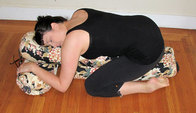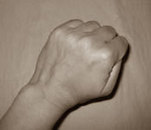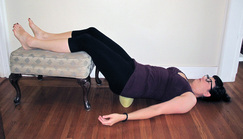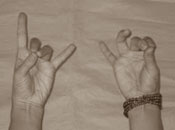|
1/12/2015 Home Practice: In the AfternoonBy the afternoon, many of us are feeling lethargic and exhausted. This is the perfect time to find a quiet place for some restorative yoga. Even if you work at an office, close your door or find a personal phone call room and give yourself a 20 minute yoga break. These three restoratives are paired with a mudra and a pranayama practice that combine to provide a short oasis for stress and leave you feeling calm yet awake and ready to face the rest of your day. Enjoy!  Supported Child's Pose Salamba Balasana Kneel straddling a long bolster. Place a second bolster over first with end of bolster in front of your low abdomen. A third bolster can go under the far end of the second bolster or use a folded blanket or block to support under it. Extend front of body over second bolster and rest forearms on bolster with hands in Adhi Mudra. Rest up to 5 minutes. Therapeutics: Creates a calm, grounded space to get away from the demands of daily life  Adhi Mudra Make a soft fist with the thumb tucked inside. Turn palms down and rest on knees. Benefits: Calms nervous system, facilitates breath in lower abdomen Practice Tips: Use when feeling anxious or insecure Contraindications: Low blood pressure Exhale Retention Rechaka Kumbhaka Inhale through nostrils, then exhale completely through nostrils and pause after the exhalation holding the breath out. The length of the pause should be comfortable to maintain. Benefits: Calming, grounding, quiets the mind  Reclining Bound Angle Pose Supta Baddha Konasana Sit in front of two long-fold blankets or a bolster parallel to mat. Place soles of feet together and let knees move apart resting on blocks or bolster. Place looped strap around back of pelvis between thighs and over outside edge of feet to help lengthen low back. Lie back over bolster and place blanket under head. Place hands in Urdhva Merudanda Mudra. Rest 5-15 minutes, then release. Therapeutics: Relaxes floor of pelvis, opens belly and chest, creates a sense of safety and calm  Urdhva Merudanda Mudra Make a soft fist and extend thumb away from palm; Lightly press fingernails into the palm; rest back of hands on thighs with thumbs pointing away from each other. Benefits: Energizes nervous system Practice Tips: Use when feeling lethargic or depressed Contraindications: High blood pressure Elevator Breath Imagine that the breath is like an elevator car that could travel up and down the length of the spine. Imagine that the elevator shaft is aligned along sushumna nadi, the energetic channel that runs from the perineum in the pelvic floor to the crown of the head. Upwards Variation: As you inhale, imagine the breath travelling down the spine from crown to pelvic floor. As you exhale, imagine the breath travelling upwards from the pelvic floor to the crown of the head. Practice for 10-20 rounds of breath, then allow the breath to return to normal. Benefits: Creates a sense of lift on the inhalation and grounding on the exhalation, lengthens both inhale and exhale.  Instant Maui Lie on back with legs in the seat of a chair. Lift pelvis off floor and place block or a folded blanket under pelvis. Place arms away from sides and palms up with hands in Pushan Mudra. Rest 15 minutes. Therapeutics: Induces relaxation response, reduces swelling of feet and legs, relaxes lower back Contraindications: High Blood Pressure  Pushan Mudra Right Hand: Touch tips of thumb, index & middle fingers together, extend all others. Left Hand: Touch tips of thumb, middle & ring fingers together, extend all others. Rest hands with palms up. Benefits: Activates relaxation response Practice Tips: Use when you feel like you are internalizing the stressors in your life Alternate Nostril Breath
Nadi Shodhana Inhale through right nostril, exhale through left nostril, inhale through left nostril, exhale through right nostril, repeat for 10 rounds at a time, monitoring the effects. Psychic Method: Breathe in and out through alternate nostrils using your imagination. This method has a subtler affect but is easier to do lying down. Benefits: Balances the sympathetic nervous system (fight or flight) and the parasympathetic nervous system (rest and digest), increases communication between the right and left hemispheres of the brain.
0 Comments
Leave a Reply. |
Index:Archives:
September 2022
I attend Cheryl's class regularly and feel that my practice has improved immensely over the past few years due to her expert coaching. Her teaching style is clear and compassionate and her previous experience in teaching adults is evident in her organized approach and easy to understand instructions. I also appreciate that Cheryl not only teaches us about how to correctly position ourselves, but also touches on many aspects of yoga philosophy, which in turn has deepened my personal practice and heightened my awareness of the connection between mind and body, breath and relaxation. |

 RSS Feed
RSS Feed
